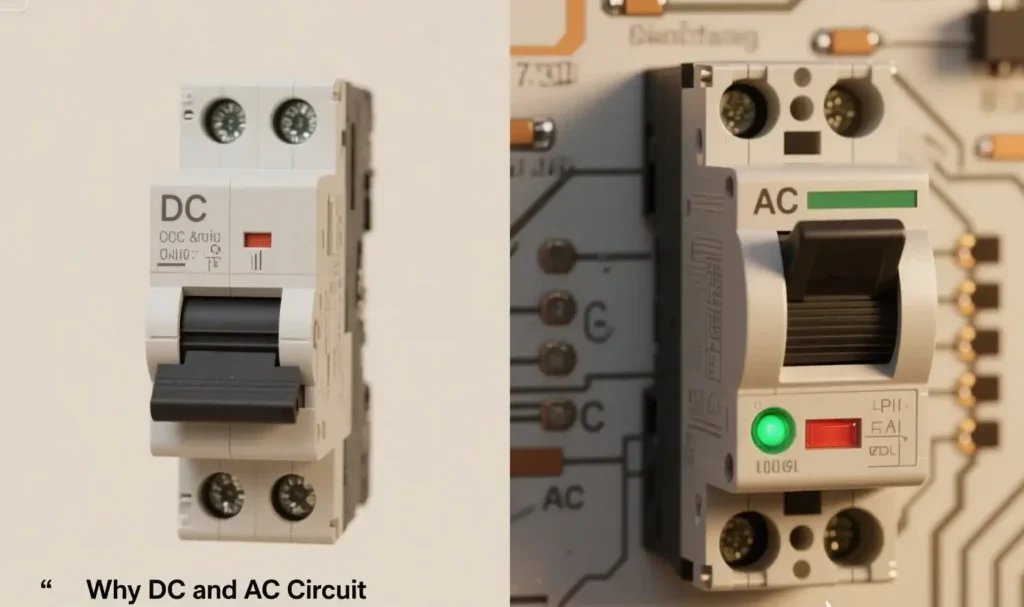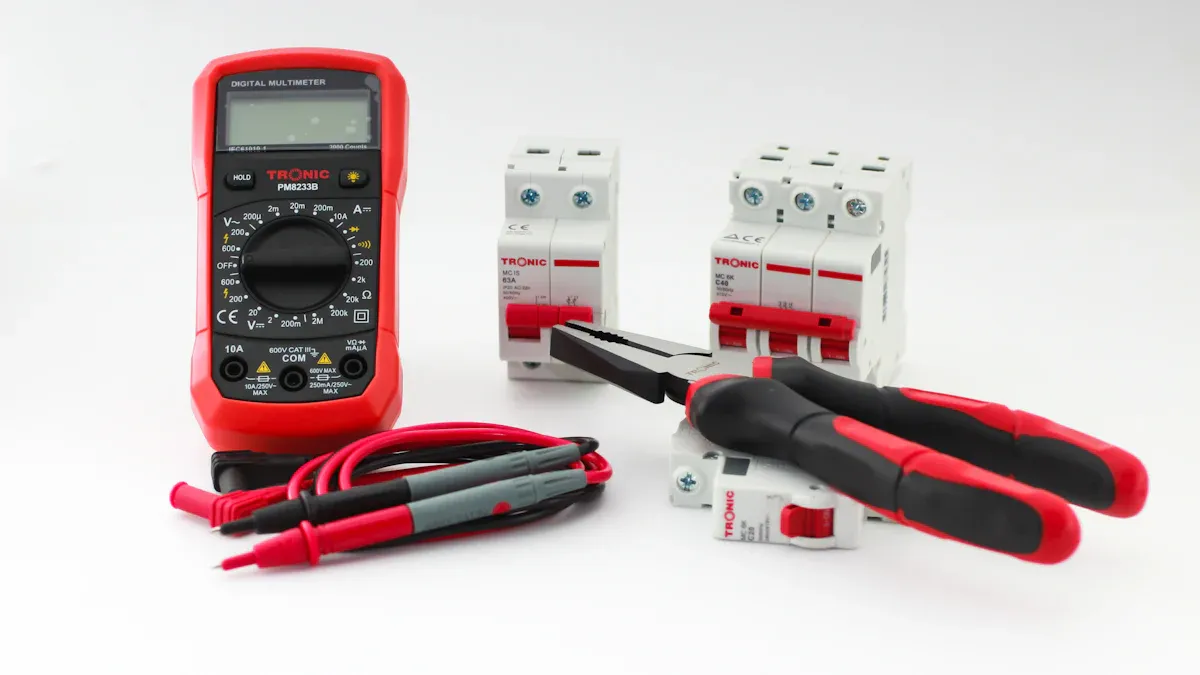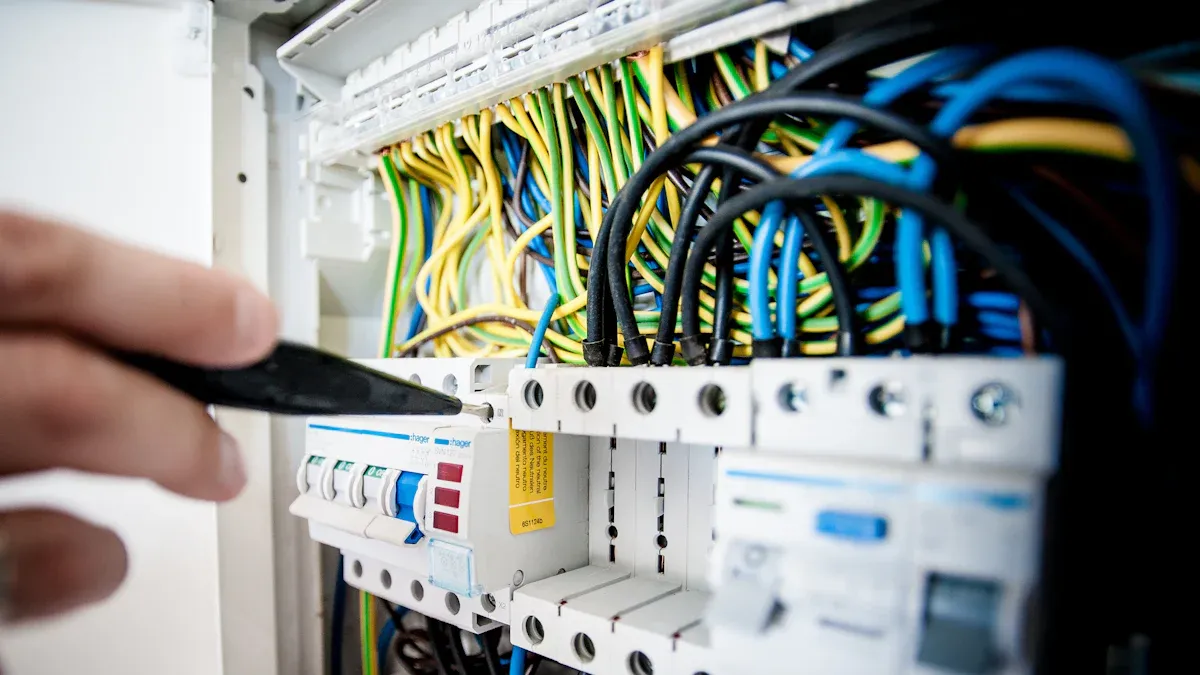You might think DC circuit breakers and AC breakers are the same, but they are not. These breakers are designed to handle how DC and AC work differently. DC moves in one direction, while AC switches directions back and forth. This difference affects how DC circuit breakers stop electrical sparks. Using the wrong breaker can be very dangerous. It might cause fires or electric shocks. It can also damage machines and stop them from functioning properly. Always use the correct DC circuit breakers or AC breakers to stay safe and keep everything running smoothly.
Key Takeaways
-
DC and AC circuit breakers are not the same. Using the wrong one can cause fires or electric shocks.
-
AC current stops flowing at zero points, making it easier to control. This makes AC breakers simpler and cheaper to make.
-
DC current flows steadily without stopping, which is harder to control. DC breakers need special designs to handle electrical sparks safely.
-
Always read the labels on circuit breakers to use the right one for your system. If you are unsure, ask a licensed electrician for help.
-
Using the correct breaker keeps your equipment safe and your electrical system working well.
Key Differences Between AC and DC Currents
Knowing how AC and DC differ helps explain why their circuit breakers are not the same. These two types of electricity act differently, which changes how they work with circuit breakers.
Characteristics of AC Current
AC, or alternating current, moves back and forth in a wave-like pattern. It switches direction many times per second, like 50 or 60 times, depending on where you live. This switching creates moments when the current drops to zero. These “zero points” make it easier to stop the electricity flow. That’s why AC is common in homes and businesses.
AC is also very useful for sending power far away. It can travel long distances with little energy loss because it can be changed to higher voltages. For example, the electricity in your house likely came from far away through high-voltage AC lines. Then, it was lowered to a safer voltage for your home. This makes AC great for powering cities and towns.
Characteristics of DC Current
DC, or direct current, flows in one steady direction. It doesn’t switch directions or have zero points like AC. This steady flow makes DC perfect for things like batteries, solar panels, and electric cars, where stable power is needed.
But DC has a challenge. Without zero points, stopping DC electricity is harder. When a breaker stops DC, it creates an electrical arc that’s tough to control. DC breakers need special designs to safely stop this arc.
DC is becoming more popular in renewable energy. Solar panels make DC power, which can be stored in batteries or changed into AC for homes. Even though DC is useful, it has issues like converting voltage and building systems for it, which slows its growth.
Impact of Current Type on Circuit Breaker Design
The way AC and DC work changes how their breakers are made. AC breakers use the zero points in AC to stop electricity easily. This makes them simpler and cheaper to build.
DC breakers, however, must stop a steady flow of electricity without zero points. They need more advanced designs, like special materials or hybrid systems, to safely stop the current. For example, DC breakers use high-tech parts to handle the energy and protect the system.
Here’s a table showing the main differences between AC and DC breakers:
|
Feature |
||
|---|---|---|
|
Trip Mechanism |
Uses thermal-magnetic sensing. |
Uses special designs like melting alloys. |
|
Arc-Quenching |
Uses natural zero points. |
Needs advanced methods for steady current. |
|
Application |
Found in homes and businesses. |
Used in solar panels, batteries, and electric cars. |
These differences show why AC and DC breakers cannot replace each other. Each is built to handle its own type of electricity.
Design and Functionality of DC Circuit Breakers
Arc Formation in DC Systems
Stopping direct current is harder than stopping alternating current. DC flows steadily and has no natural zero points. These zero points help stop electricity in AC systems. Without them, breaking a DC circuit creates an electrical arc. This arc is very hot and can harm the breaker or nearby equipment. The arc’s strength depends on the breaker’s capacity and system voltage. Controlling this arc is very important for safety and proper function in DC systems.
Arc-Quenching Mechanisms in DC Circuit Breakers
DC breakers use special methods to control strong arcs. These methods cool and stretch the arc to stop it safely. For example:
-
Air arc chutes pull and cool the arc to lower its power.
-
Vacuum interrupters remove the arc using a vacuum, making them reliable and easy to maintain.
-
Molded-case circuit breakers (MCCBs) use arc chutes to cool arcs and protect the breaker’s parts.
Some systems, like the Arc Vault, stop arcs in under eight milliseconds. This makes DC breakers safer and more dependable. These technologies help DC breakers handle the tough demands of direct current systems.
Applications of DC Circuit Breakers
DC breakers are important in many industries. They stop currents during problems to keep systems safe and working well. Here are some main uses:
|
Application Area |
Key Insights |
|---|---|
|
Protects systems in renewable energy setups like solar panels. |
|
|
High Voltage Direct Current (HVDC) |
Needed for long-distance power transfer in HVDC systems. |
|
Vacuum-Insulated Breakers |
Great for tough environments due to high reliability and low upkeep. |
DC breakers are also used in electric cars, batteries, and factory machines. Their ability to handle DC currents makes them essential in today’s electrical systems.
Design and Functionality of AC Circuit Breakers
Role of Zero-Crossing in AC Systems
In AC systems, the current switches directions repeatedly. This creates moments called zero-crossings, where the current briefly stops. These zero-crossings are very important for AC circuit breakers. When the breaker stops the current, the zero-crossing helps end the electrical arc. This pause in current flow makes stopping electricity safer and easier. It’s like a natural feature of AC that helps circuit breakers work better.
Arc-Quenching Mechanisms in AC Circuit Breakers
AC breakers use special methods to handle arcs when stopping current. These methods use zero-crossings to quickly end the arc. For example:
-
Air circuit breakers cool and stretch the arc using air.
-
Oil circuit breakers put the arc in oil to absorb heat and stop it.
-
Vacuum circuit breakers work in a vacuum, where no air means no arc can form.
Each breaker type is made for specific electrical needs. This ensures safety and reliability. The table below explains air circuit breakers, a common type used in AC systems:
|
Aspect |
Description |
|---|---|
|
Types |
Lists different air circuit breaker types and their features. |
|
Functions |
Explains how air circuit breakers work in AC systems. |
|
Applications |
Shows where air circuit breakers are used in electrical setups. |
Applications of AC Circuit Breakers
AC breakers are used in many important areas. They stop current during problems to keep systems safe. Here are some examples:
-
They protect homes and buildings from electrical dangers.
-
They improve old electrical systems and support smart city projects.
-
They help connect renewable energy to the power grid safely.
-
In factories, they protect machines by stopping power during faults.
-
They manage energy use by controlling power loads and saving energy.
These uses show why AC breakers are so important. They keep homes, businesses, and power grids safe and working well.
Risks of Switching DC and AC Circuit Breakers
Using the wrong circuit breaker can cause big problems. DC and AC breakers are made for specific jobs. Mixing them up can lead to safety issues, broken equipment, or system damage. Let’s look at these risks more closely.
Safety Problems
Using the wrong breaker can be very dangerous. DC breakers are made for steady direct current. If you use an AC breaker in a DC system, it can’t handle the arc. This arc can melt parts of the breaker and cause overheating. Overheating might start a fire. AC systems need more insulation for voltage spikes. A DC breaker in an AC system could cause shocks or short circuits.
These dangers can have serious results. Fires from overheating can spread fast and harm people or property. Electrical shocks can hurt anyone near the faulty system. Always pick the right breaker to stay safe and avoid these risks.
Equipment Damage
Switching DC and AC breakers can harm your devices. DC systems need breakers that handle steady current without zero points. An AC breaker in a DC system might fail to stop the current. This failure can create arcs that damage the breaker and devices. A DC breaker in an AC system might break down insulation, harming parts of the system.
For example, in solar panel setups, the wrong breaker can ruin the system. This damages costly equipment and leads to expensive repairs. Using the right breaker protects your devices and keeps them working.
System Problems
Mixing up breakers can cause system-wide failures. If a breaker can’t stop the current, it can create bigger problems. This is especially bad in factories or high-voltage systems. One failure can cause power outages everywhere.
Studies show how wrong breakers lead to failures. For example:
|
Study Description |
Key Findings |
|---|---|
|
Expert tests |
Found many brands of breakers failed often. |
|
Common-cause failures study |
Looked at breaker failures over 20 years. |
|
SF6 breaker analysis |
Studied 1546 breakers and found reasons for failures. |
These studies prove why using the right breaker is so important. Wrong breakers can fail under pressure, causing danger and downtime. Following proper testing rules keeps systems safe and reliable.
By knowing these risks, you can choose the right breaker. If unsure, ask a professional for help. This keeps your system safe and avoids costly errors.
Exceptions and Temporary Use Cases
When Switching Breakers Might Be Allowed
Sometimes, you might think about swapping DC and AC breakers. This should only happen in emergencies, like when the right breaker isn’t available, and the system must keep running. Even then, it’s important to check for risks and follow safety rules.
Here are some things to do in such cases:
-
Check for dangers by doing a risk assessment.
-
Use tools to test if the breaker can handle the current.
-
Make sure all equipment is grounded to reduce risks.
-
Look for damage on tools and equipment before using them.
The UW Electrical Safety Program says safety codes must be followed. This protects people and prevents fires, even in temporary situations.
Warnings and Dangers of Temporary Use
Using the wrong breaker, even for a short time, is risky. A breaker made for a different current can overheat or fail. This can cause fires, shocks, or damage to equipment.
Here’s a table with safety tips to lower these risks:
|
Safety Tip |
What It Means |
|---|---|
|
Know limits |
Understand what your tools and equipment can handle. |
|
Spot dangers |
Look out for risks like fire, shocks, or arc flashes. |
|
Learn about equipment |
Read labels and understand what they mean. |
|
Report problems |
Tell someone if you see unsafe conditions. |
|
Use licensed electricians |
Only trained experts should work on electrical systems. |
Even with these steps, using the wrong breaker should not last long. Replace it with the correct one as soon as you can.
Why You Should Ask an Expert
Before switching breakers, talk to a licensed electrician. They know the rules and can help you stay safe. Experts can check your system, find problems, and suggest the right breaker.
Here’s why asking an expert is smart:
-
Electricians know how to safely work with tricky systems.
-
They can find hidden issues, like old wiring, that might fail.
-
Licensed experts make sure the job follows safety standards.
-
You’ll feel better knowing your system is safe and working well.
If you’re a homeowner, getting help from an electrician is very important. They have the right tools and skills to do the job safely. This keeps your system working longer and protects you from danger.
By asking an expert, you avoid mistakes and keep your system safe. Temporary fixes might seem easy, but expert advice is key for long-term safety.
DC and AC circuit breakers work with different kinds of electricity. Using the wrong breaker can lead to fires, shocks, or broken equipment. Always use the right breaker for the type of current in your system.
Tip: Look at the labels on your circuit breakers first. If you don’t know which to use, ask a licensed electrician for advice.
Picking the right breaker keeps your system safe, dependable, and up to code.
FAQ
What happens if you use an AC circuit breaker in a DC system?
Using an AC breaker in a DC system is unsafe. AC breakers need zero-crossing points to stop arcs. DC systems don’t have these points. This can cause arcs to keep going, overheating the breaker. Overheating may damage the breaker and create safety risks.
Can DC circuit breakers work in AC systems?
DC breakers are not made for AC systems. They don’t have the right insulation or tools to stop AC arcs. Using a DC breaker in an AC system can cause short circuits or fires. It might also harm your equipment.
Why do circuit breakers fail when used incorrectly?
Circuit breakers fail when used the wrong way. Each breaker is made for a specific type of current. Using the wrong one can cause arcs that won’t stop. This damages the breaker, overheats it, and makes your system unsafe.
How can you identify the correct circuit breaker for your system?
Look at the labels on your circuit breakers. These labels show the type of current and voltage they handle. If you’re not sure, ask an electrician. Picking the right breaker keeps your system safe and working well.
What is the role of arc extinguishing in circuit breakers?
Arc extinguishing stops dangerous arcs when a breaker trips. AC breakers use zero-crossing points to stop arcs. DC breakers use special tools like air chutes or vacuums. Stopping arcs protects the breaker and nearby equipment from harm.
The following information may be of interest to you
How to replace the circuit breaker correctly
The difference between AC MCB and DC MCB
What Makes AC Better Than DC for Homes





